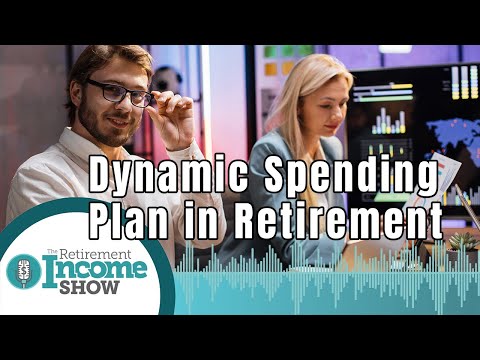What’s a Dynamic Spending Plan and How It Can Help You Through Retirement
Mark Elliot: Welcome back to The Retirement Income Show. I’m Mark Elliot alongside the CEO and founder of Oak Harvest Financial Group, Troy Sharpe. You can always go to the website to find out more, a phenomenal website, oakharvestfinancialgroup.com, oakharvestfinancialgroup.com. Over 100-plus videos on YouTube. Just search for Troy Sharpe and Oak Harvest. There are scenarios, there’s social security. Everything retirement or financially related you can think of, Troy’s probably got a video on that. There’s no cost to subscribe. If you click on the bell, you’re going to get all the new ones as well. They’re always updating the YouTube channel. Just search for Troy Sharpe and Oak Harvest.
Of course, the office of Oak Harvest, located at 920 Memorial City Way, right off I-10 and Bunker Hill, maybe the easiest. Just give them a call if you got some questions, 800-822-6434, 800-822-6434. They operate under the fiduciary standard, but the retirement process starts with investment planning, then income planning, tax planning, health planning, and then, of course, it goes to the estate plan. Social security. What about that? Well, that’s in the income part. What about Medicare? There’s big decisions to make there. That’s in the healthcare part.
There’s a lot of moving parts and they’re all tied together. Let’s go to your second level of the Retirement Process Process, and you brought it up. You were talking about income planning because you started with investments and all the challenges and the decisions we make and some of the repercussions of a bad decision certainly can play into that. You said you believe in dynamic income planning. I’ve never heard you say that. I don’t know what you’re talking about.
Troy Sharpe: Well, it’s more of a dynamic spending plan in retirement. Most of the advice out there, if you’re reading online, if you’re talking to a general practitioner, someone on one of the big brokerage firms. I don’t speak bad about other advisors, but there’s, let’s say a lack of creativity, a lack of flexibility, a lack of the ability to even go outside the firm’s rigid standard. We talked a lot about dynamic allocation on that last segment. Now, I didn’t use that term “dynamic allocation”, but there’s a concept out there and I’m going to get to your question here, Mark, I like to call it, “What is your risk scale?”
When we look at retirement planning, I believe there should be a dynamic allocation component as well as a dynamic spending component. When we talk about the dynamic allocation, we’re talking about your investment portfolio. Let’s say you go into a big brokerage firm, the big box store, they’re all over, and you tell them you’re a conservative investor. Well, 60% to 75% of your money will be in bonds and 60% to 75% of your money is likely to earn zero. Probably negative when we take into account inflation. Bonds simply don’t pay much interest today, and as interest rates rise, bonds are likely to lose value.
Then when you look at what we call the real return of those bonds, so the nominal return is prior to inflation, technical term, they’re nominal, the real return is the inflation-adjusted. If you make 1% in your bonds and inflation’s running at 5%, you’re at -4 real return, but if you have a rigid firm that– What is a rigid firm? Someone who has a boss who has a boss who has a boss who has a boss who has a boss and they have 20,000, 30,000 financial advisors across the country.
From a top-down management approach, how do I control 20,000 to 30,000 advisors? Well, many of you have run companies, many of you are managers, you put policies, systems, procedures in place and then you people accountable to those policies, procedures, and systems. If someone comes in and says they’re conservative, they’re probably going to be 25% stock, maybe 75% bonds.
Now, that same person that is conservative, if we look at a risk scale, meaning if the market is down, if you’re 58 years old, if the federal reserve is pumping trillions of dollars into the market, if jobs are coming back, if the economy is improving, do you want to have more of an allocation to equities to participate a higher percentage in that rebound? Some people say, “No, absolutely not, Troy. I’m scared of the market. I don’t want any money in the market or as very little as I possibly have to in order to meet my goals.” Well, that person would be low on the risk scale because they’re not really willing to be a little bit flexible, get a little bit more aggressive when things are good.
Someone who is more high on this risk scale, maybe you’re a 50/50 type typical portfolio allocation in retirement or approaching retirement. Coming out of the pandemic, when we’re getting trillions of dollars pumped into the market, maybe in that scenario you want to be a little bit more aggressive because you have some years before retirement. You believe that the market is going to go up. We’re having conversations. We strongly believe the market was going to come up coming out of the pandemic. You can go back and look at our outlook in 2020, outlook in 2021. It’s on the website. You can go to the YouTube channel, look up our coronavirus market updates.
Point is, that particular person who has a more dynamic or is higher on a risk scale, should be allocated a little bit more to equities in that timeframe. Now, the portfolio, that’s a dynamic allocation based on monetary policy, based on economic policy, based on where we’re at in the economic cycle, based on how far are away from retirement. Your risk tolerance can be flexible. Now, it’s not right for all of you, but the concept is what I’m trying to get across. Now we have the dynamic spending component. Again, antiquated rules, very rigid systems out there.
If you’re going to go to a certain type of advisor, their entire income plan for you is going to be you retire, you take 4% out of the portfolio, you let your IRAs defer as long as possible, which by the way, you’re creating a massive tax nightmare for yourself down the road. If you’ve listened to me for any amount of time, you know that I am not a fan of deferring those retirement accounts indefinitely or until RMD age, but a dynamic spending plan in retirement instead of just taking 4% out per year and then adjusting upwards for inflation, that’s a very rigid, that’s a very static type income plan.
Not to mention, you’re not getting advice on which accounts you should be taking that 4% from. How much from the retirement account? How much from the non-IRA? Again, most of these advisors, there are a lot of really, really good advisors out there that are stuck in rigid systems. They want the job security. They can’t go elsewhere. They don’t want to risk going elsewhere, so they have to do what their boss and boss’s and boss’s and boss’s and boss’s boss tells them to do.
That’s why I started my own company, so I don’t have to do that. We can always operate in someone’s best interest, but we can have conversations. We can not only have a dynamic portfolio allocation but we can also have a dynamic spending plan where we’re sitting down. The one thing we require with clients is relationships, and we also require that you show up for your reviews. We’re doing two reviews a year with our clients because we’re talking about the investment plan, the income plan, the tax plan.
There’s no need to meet quarterly typically because things just don’t change every three months, but we do want to be meeting twice a year. Typically, people that have been with us for four, five, six years, they’ll typically go to once a year because it’s just at that point. Once a year is sufficient for a lot of people. Let’s say the portfolio has a really good year. We don’t need to necessarily just take 4% out.
If you want to take the kids and the grandkids to the beach house and you want to pay for everything so they can all come, well, guess what? We’re connected to our plan because know how much we have, we know approximately how long it’s going to last; we have a tax strategy. That’s a dynamic spending plan. In a good year, we can take more out than that 4%, but we just don’t do so willy-nilly. We do so while we’re connected to our retirement plan and we go through and we put on the big television screen, we look at the numbers, the analysis.
If you spend $20,000 on this trip, this is what it does to you in future years. Because if you remember back to last segment, we talked about the value and the power of decisions. We have to look at money in the context of time. If you take $20,000 out, it’s not just costing you $20,000, because if that $20,000 they’d invested and 20 years from now it’s 7%, it’s worth about $80,000. We’re really taking $80,000 out of either a long-term care fund, or assisted living, or inheritance.
We have to have those conversations, but when we sit down and we say, “You know what? Market had a really good year this year. What do you want to do? What are your goals? What are your dreams? What do you want to spend money on?” Then we tie that to the plan. Also, if we’re going to take that money out, guess what that does? That impacts the tax plan, because if we’re doing conversions, then we’re probably going to do less conversions that year because now our income has been increased because of the distribution.
Sometimes that could reduce the income because if we’re taking it from the non-IRA account because we’ve maxed out our tax bracket on the Roth conversion strategy, now we have less dividends and interest. Although granted that’d be a modest reduction, but still, it can go both ways. Let’s say the market has a bad year. Well, we believe in having secure money for a part of the portfolio. Many people will be taking part of their income plan, will be taking money from that secure bucket during those years.
We don’t have to worry about necessarily the short-term impact of a market decline because our clients typically have some secure money where they’re taking their income from, but maybe people are aggressive. We have some clients that are 100% stock because they have a long timeframe, their risk tolerance is very high, and they believe long term in the markets. Well, those people, maybe we have a dynamic spending plan where we cut back a little bit. That’s really what a dynamic spending plan is.
It’s being connected not only to your money but your money being connected to your plan and you always having access to that and knowing that if I make this decision, this happens. If I make this decision, this happens. 1-800-822-6434. This is what it’s like to work with us. All of our advisors walk you through this process. This is what it’s like to be a client. This is what the reviews are like. This is what it’s like at Oak Harvest Financial Group because we want to be a firm that we require to have relationships with you because this is what we do. This is our career path. This is what we’ve chosen to do with our lives. Again, we started the firm because of what I experienced with my grandparents.
Many of you have heard this before, but my grandparents retired, couple million dollars, simple people. They didn’t have an income plan. They didn’t have a proper investment strategy. They definitely didn’t have a tax plan. They had no healthcare plan. They lost about $1 million in the first couple of years of retirement due to healthcare expenses, bad investment decisions, or recommendations I should say. Just a lack of overall planning.
I opened Oak Harvest to be a firm that if we had existed then, my grandparents could have walked in, sat across the table from a fiduciary, someone who is going to always operate in their best interest and put a plan together and then be there with them every step of the way throughout retirement. If that’s something that you value, something you could see as possibly being a part of your retirement, give us a call. The phone number is 1-800-822-6434. Check out the videos on YouTube. Of course, go to the website. We have a ton of good information out there, oakharvestfinancialgroup.com.
[music]
Having a dynamic spending plan in retirement helps you adapt and change to current economic, tax and political trends. At Oak Harvest Financial Group, we strive to be your partner in helping you develop a strategic dynamic spending plan to help you achieve your goals.




